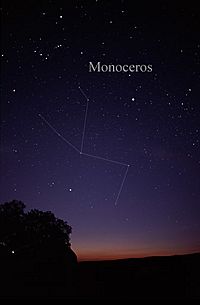Monoceros facts for kids
| Constellation | |

List of stars in Monoceros
|
|
| Abbreviation | Mon |
|---|---|
| Genitive | Monocerotis |
| Pronunciation | genitive |
| Symbolism | the Unicorn |
| Right ascension | 7.15 |
| Declination | −5.74 |
| Quadrant | NQ2 |
| Area | 482 sq. deg. (35th) |
| Main stars | 4 |
| Bayer/Flamsteed stars |
32 |
| Stars with planets | 16 |
| Stars brighter than 3.00m | 0 |
| Stars within 10.00 pc (32.62 ly) | 2 |
| Brightest star | β Mon (3.76m) |
| Messier objects | 1 |
| Meteor showers | December Monocerids Alpha Monocerids |
| Bordering constellations |
Canis Major Canis Minor Gemini Hydra Lepus Orion Puppis |
| Visible at latitudes between +75° and −90°. Best visible at 21:00 (9 p.m.) during the month of February. |
|
Monoceros (Greek: Μονόκερως) is a constellation on the celestial equator. Its name is Greek for unicorn. It was described by 17th-century Dutch cartographer Petrus Plancius. Orion is to the west of Monceros. Gemini is to the north. Canis Major is to the south. Hydra is to the east. Other constellations next to Monoceros are Canis Minor, Lepus and Puppis.
Contents
Notable features
Stars
Monoceros is hard to see with the naked eye. Its brightest star, Alpha Monocerotis, has a visual magnitude of 3.93. It is brighter than Gamma Monocerotis at 3.98.
Monoceros does have some interesting features to look at with a small telescope. Beta Monocerotis is a triple star system. The three stars form a triangle which looks to be in one spot. William Herschel commented that it is "one of the most beautiful sights in the heavens".
Monoceros also has Plaskett's Star. It is a big binary system. Its whole mass is said to be that of almost 100 Suns put together.
Images for kids
-
The constellation Monoceros, from Urania's Mirror, a set of star charts from 1825. Includes Canis Minor and the obsolete constellation Printer's Workshop
See also
 In Spanish: Monoceros para niños
In Spanish: Monoceros para niños



